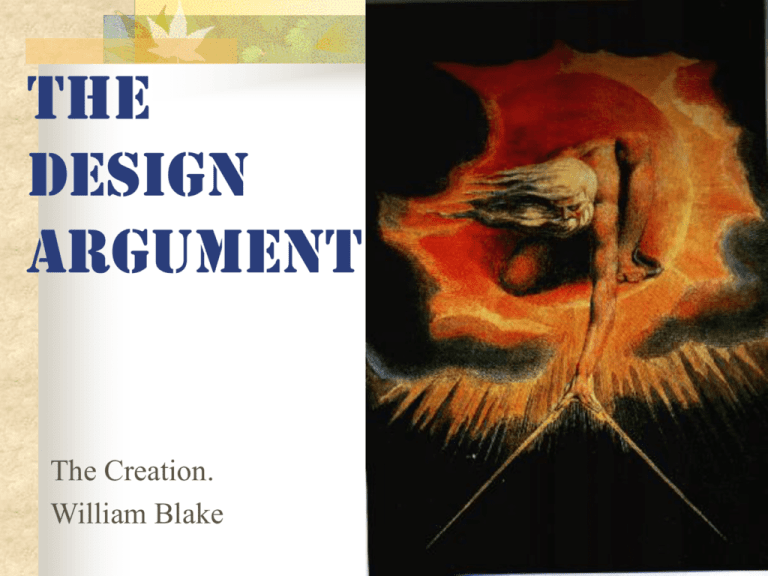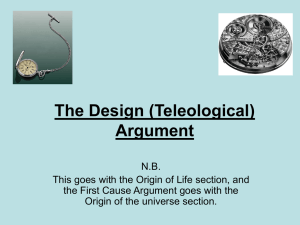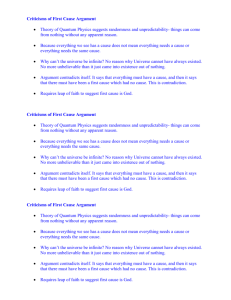Teleological Argument File
advertisement

THE DESIGN ARGUMENT The Creation. William Blake This Powerpoint presentation is prepared by Dr. Peter Vardy, Vice-Principal of Heythrop College, University of London for Heythrop College, DIALOGUE EDUCATIONAL VIDEOS. Copyright reserved University of London, is the specialist theology and Philosophy College of the University. It offers undergraduate and postgraduate courses in Theology, Philosophy, Philosophy of Religion and Ethics. www.heythrop.ac.uk DESIGN ARGUMENTS These are A POSTERIORI – they start from experience in the world and attempt to argue to God There are three types: 1) TELEOLOGICAL ARGUMENTS Arguments from a general pattern of order in the Universe. Why are there scientific laws at all and where do they come from? 2) FROM PROVIDENCE Arguments from the claim that the needs of human and other beings are provided for, and 3) ARGUMENTS FROM BEAUTY Arguments from the existence of beauty in the world. The first two are closely linked and are often not separated clearly PALEY AND HUME William Paley was Archdeacon of Carlisle: Paley: Imagine crossing a heath. If you come across a stone, you might consider it to be an accident but if you come across a watch then this provides clear evidence of contrivance or design even if the purpose of the watch is not obvious. Just as the design of the watch implies a designer, so the design in the world implies a great designer – which is God. His argument was criticised by Hume 23 years BEFORE Paley put it forward. This was a mark of the gap between philosophy and theology at the time. HUME’S THREE CHARACTERS Hume sets out his argument through three characters: CLEANTHES – who uses Natural Theology (based on reason) to argue from the world to God DEMEA – who starts with a faith position, and PHILO – who puts forward Hume’s own, sceptical, position. 1) 2) 3) 4) Cleanthes puts forward an argument very similar to that later to be put forward by Paley: Design implies a designer The Universe is clearly designed. There is great design in the Universe which is like a machine, This implies there must be a Great Designer of the Universe. PHILO’s FIRST REPLY Central to Cleanthes’ argument is that like effects presuppose like causes. This means that, if the argument succeeds, it points to God being like a superman figure. This is because the closer the analogy between design in the world and design of the world, the closer the parallels between God and human beings. Look at the evidence, says Philo. Perhaps this Universe is the product of a trainee God, or a senile God because although there is evidence of good design there also appears to be evidence of poor design. Perhaps there are many gods, male and female, who co-operate together. After all many humans collaborate to produce a great ship, so if there is a close analogy between design IN the universe and design OF the universe as a whole, this would point to anthropomorphic gods. Perhaps many gods collaborate to produce the universe and the design is not very good. If, on the other hand, it is said that there are only weak links between design within the universe and design of the Universe as a whole, this weakens the whole argument. PHILO’S SECOND REPLY 1) The world is ordered 2) This order either results from design or chance 3) It is perfectly possible that order arose from chance, as: i) ii) iii) iv) Matter and energy may well be everlasting (this anticipated Einstein’s findings that the total stock of matter and energy in the Universe may be constant), If this is so, then in an infinite number of combinations all possibilities will be realised. Once order has occurred it will tend to perpetuate itself.This assumption may be rejected as entropy implies that there may be a tendency in the opposite direction Animal adaptation cannot be used to prove design, as if animals did not adapt they would not survive. Philo’s conclusion is that we should suspend judgement as to whether there is a God. RICHARD SWINBURNE Imagine 10 card shuffling machines. A madman kidnaps someone and ties them to a chair. He sets the card shuffling machines going and says that a box of explosives will blow up unless every pack shows an ace of hearts. When the victim survives, he will be convinced that the ‘dice must have been loaded’ but the madman will reply that he could not see anything else – as he would otherwise be dead. Similarly the odds of human beings coming to be are so huge that the probability is that there is an intelligence behind the universe. Fred Hoyle supports Swinburne’s conclusion: ‘A component has evidently been missing from Cosmological Studies. The origin of the Universe, like the solution to the Rubik cube, requires an intelligence. (‘The Intelligent Universe’ p. 189) ‘…properties seem to run through the natural world like a thread of happy accidents. But there are so many of these odd coincidences essential to life that some explanation seems required to account for them.’ Swinburne’s conclusions It is very unlikely that the Universe has just happened to exist. Given the character of God postulated by the main monotheistic religions, this is just the sort of world God would have reason to create Whereas the Design argument does not prove the existence of God, it does make it more probable than not that God exists. HOWEVER assessing probability is very difficult and much depends on individual opinion so it is important to assess Swinburne’s possible bias… Peter Vardy also argues that he fails to take real account of the problem of evil and negative factors in the Universe. RICHARD DAWKINS The title of Dawkins’ book, ‘The Blind Watchmaker’, refers to Paley’s argument He claims that natural selection is ‘blind’, it has no aim, no purpose. It is a ‘blind, unconscious automatic process’ completely without purpose: “Evolution has no long term goal. There is no long term target, no final perfection to serve as a criterion for selection… The criterion for selection is always short term, either simply survival or, more generally, reproductive success. The ‘watchmaker’ that is cumulative natural selection is blind to the future and has no long term goal.” DAWKINS Contd. In ‘The Selfish Gene’ Dawkins claims that humans only act so that their genes may survive. All we are is mechanisms to pass on our genes in competition with other species. We are simply the mechanisms used by our genes to replicate themselves: ‘We are survival machines – robot vehicles blindly programmed to preserve the selfish molecules known as genes.’ Human beings have evolved to meet the conditions available. There is no purpose and no meaning to our existence – we are simply what has evolved and our ability to understand our place in the Universe is remarkable and fills Dawkins with awe. Richard Dawkins and Peter Williams Dawkins understands human beings strictly in terms of biology - we have about 5 billion cells each containing 46 chromosomes and 23 base pairs. Each chromosome contains tens of thousands of genes. Dawkins describes DNA as follows: ‘It is raining DNA outside. On the banks of the Oxford canal at the bottom of my garden is a large willow tree and it is pumping downy seeds into the air.... not just any DNA but DNA whose coded characteristics spell out specific instructions for building willow trees that will shed a new generation of downy seeds. These fluffy specks are literally, spreading instructions for making themselves. They are there because their ancestors succeeded in doing the same. It’s raining instructions out there. It’s raining programmes; it’s raining tree-growing, fluff spreading algorithms. This is not a metaphor, it is the plain truth. It couldn’t be plainer if it were raining floppy discs.’ Dawkins ‘The Blind Watchmaker’ 1986 p. 111 Peter Williams agrees that there is a strong analogy between DNA and a computer disc but he maintains that as we know that computer programmes come from minds, we should similarly assume that DNA comes from a mind - the mind of God. Williams – Contd. Science falls silent when asked for an explanation for the ultimate nature of the natural laws that give rise to order and that generate the processes that bring DNA about. Williams quotes Behe: As Michael Behe says: ‘If you search the scientific literature on evolution, and if you focus your search on the question of how molecular machines - the basis of life - developed, you find an eerie and complete silence.’ For example, the Journal of Molecular Evolution was established in 1971, and is dedicated to explaining how life came to be at the molecular level. None of the papers published in JME has ever proposed a possible route for a single complex biochemical system to arise in a gradual step-by-step Darwinian process.’ Critics of this argument hope for some naturalistic explanation to emerge for the existence of the mechanisms which are necessary to generate DNA - but whether this will emerge is still debatable. DOES EVOLUTION EXPLAIN ENOUGH? Williams maintains that a supernatural origin is required not for the DNA itself but for the processes which bring the DNA about: ‘To say that Darwinian evolution cannot explain everything in nature is not to say that evolution, random mutation, and natural selection do not occur; they have been observed (at least in the case of microevolution) many different times..... I believe the evidence strongly supports common descent. But the root question remains unanswered; what has caused complex systems to form?’ Michael Behe ‘Darwin’s Black Box’ p. 175-6 In other words, the principle of Natural Selection does not rule out belief in God – the question still remains as to where the whole system comes from and this, it is claimed, science cannot explain. Dawkins’ awe and wonder - 1 Dawkins claims that our coming to selfconsciousness so that we can understand ourselves is wonderful. Evolution can explain a skylark and also a Shakespeare sonnet. He claims that the spotlight of consciousness shines not just on the here and now (as it does with animals) but enables us to place ourselves in a broader setting: “The spotlight passes but, exhilaratingly, before doing so it gives us time to comprehend something of this place in which we fleetingly find ourselves and the reason that we do so. We are alone among animals in being able to say before we die: Yes, this is why it was worth coming to life in the first place…” (Unweaving the Rainbow p. 312/3) Dawkins’ awe and wonder - 2 In ‘Unweaving the Rainbow’ (1998) Dawkins shows a clear sense of awe at the Universe which we can, in our short life, begin to understand: “After sleeping through a hundred million centuries we have finally opened our eyes on a sumptuous planet, sparkling with colour, beautiful with life. Within decades we must close our eyes again. Isn’t it a noble, enlightened way of spending our brief time in the sun, to work at understanding the universe and how we have come to wake up on it?” WHO ARE YOU? Imagine that ten packs of cards are shuffled. The cards come up: 2H, JC, 5S, AH, 7D, 10D, KS, 4D, 6S, QC The odds of these coming up are astronomical. SWINBURNE effectively says: ‘What an incredible coincidence! The odds of these numbers coming up are so huge there must have been an intelligence organising this!’ DAWKINS replies ‘These are just the numbers that happen to come up and isn’t it wonderful that we can understand the processes through which this happens before we cease to be?’ (note this is very similar to Philo’s point). YOU ARE THE CARDS. Which do you think is more likely?? Peter Vardy claims that it is how you answer this question which will determine whether you find it probable or not that there is a God. The Anthropic Argument PERHAPS, HOWEVER, THE TYPES OF ARGUMENT LOOKED AT SO FAR ARE INADEQUATE PERHAPS A MORE PERSUASIVE APPROACH IS NEEDED THAT IS NOT A PROOF BUT A POSSIBLE POINTER. ONE THAT STARTS AT AN ENTIRELY DIFFERENT POINT….. THE WIND ON THE FIELDS TWO DINGOS SAYING HELLO A CATERPILLAR AND SOME FLOWERS ACCIDENT OR DESIGN? The argument from Beauty Beauty is held to have no survival value. What is the survival advantage of seeing the beauty in a snowflake; in a Spring morning or a piece of music? The facility to appreciate beauty, may be held to be a pointer towards God implanted in human beings to make them indirectly aware of His presence. F. R. Tennant argues that the universe is not just beautiful in places - it is saturated with beauty from the microscopic to the macroscopic level. Swinburne holds that there is no reason to expect a beautiful rather than an ugly world. God has some reason to make a beautiful world and some reason to leave some ugliness within the world which human beings can strive to overcome. He claims that the presence of beauty makes the existence of God more probable than not. THE FRANCISCAN TRADITION St. Francis is recognized today as the patron saint of ecology. In his Canticle Francis addresses the created world as Brother, Sister, Mother: ‘Praised be You, my Lord, through our Sister Mother Earth who sustains and governs us, and who produces varied fruits with coloured flowers and herbs.’ Francis saw all these as expressions of spiritual relationship. Francis found God in all things since all things were created by God. According to Paul Rout OFM, Francis is convinced that the Creator God is at the same time the Highest Good. This enabled Francis to perceive the world as a sacred reality since it is a reflection of God’s goodness. Problems with the argument from beauty Beauty may be ‘in the eye of the beholder’. It may be due to cultural conditioning and may not exist as some sort of absolute. If one is a non-realist about beauty, then this makes it less likely that it is implanted by God. HOWEVER The Franciscan tradition sees God as ‘luring’ human beings towards God – and it sees beauty as one of the means which God uses. It could be that God implants a faculty to recognise beauty, but this faculty is differently formed in different societies. Again, theist and atheist will differ and there seems no convincing proof… GAIA James LOVELOCK’S GAIA HYPOTHESIS “According to the Gaia hypothesis, we are part of a greater whole.. Our destiny is not dependent merely on what we do for ourselves but also on what we do for Gaia as a whole. If we endanger her, she will dispense with us in the interests of a higher value – life itself.” (Vaclav Havel, July 1994) The word ‘Gaia’ is the name of the Greek goddess of the Earth. The Gaia hypothesis rejects the anthropocentric view centred on human beings – according the the Gaia hypothesis, we are part of a greater whole. THE GAIA HYPOTHESIS IS AN HYPOTHESIS – IT MAY NOT BE VALID BUT IT IS CERTAINLY WORTHY OF DEBATE. ENTROPY The 2nd Law of Thermodynamics says that all energy will eventually dissipate into heat universally distributed. Lovelock maintained that a reduction or reversal of entropy is a sure sign of life. Life itself manipulated the atmosphere of earth and the whole earth system so as to reduce entropy. Entropy does indeed occur, but life can reverse it – and thus make more life possible. ‘..the entire range of living matter on Earth, from whales to viruses and from oaks to algae could be regarded as constituting a single, living entity, capable of manipulating earth’s atmosphere to suit its overall needs with faculties and powers far beyond those of its constituent parts.’ (Gaia p. 9) WHAT IS THE EVIDENCE? Life first appeared on Earth 3.5 million years ago yet in this time the Earth’s climate has changed very little. The chemical composition of the seas and the atmosphere runs quite against what we would expect. Lovelock maintains that the atmosphere is a biological construction – a living system engineered to maintain a chosen environment. The whole is maintained at an equilibrium from which even a tiny departure could have disastrous consequences for life. Instead of Nature being seen as a primitive force that needs to be subdued, Gaia should be seen as a complex entity involving biosphere, atmosphere, oceans and soil a living organism, maintaining and sustaining itself. HUMANS ARE PART OF THE UNITY THAT IS GAIA – NOT ITS MASTER. The GAIA HYPOTHESIS AND THE DESIGN ARGUMENT Peter Vardy has argued that Lovelock’s Gaia hypothesis may have relevance to the Design argument. It maintains that Gaia (the earth) ‘manages itself’, ‘engineers’ conditions necessary for life. The processes by which it does this may be explored by science but the religious question may still remain – what causes a Universe where such processes exist? They seem the very opposite of random processes and, therefore, one could return to Paley and maintain that an intelligence is required to put these processes in place. The Gaia hypothesis has not yet been proved, but it could provide fertile ground for a debate between scientists and theologians.





